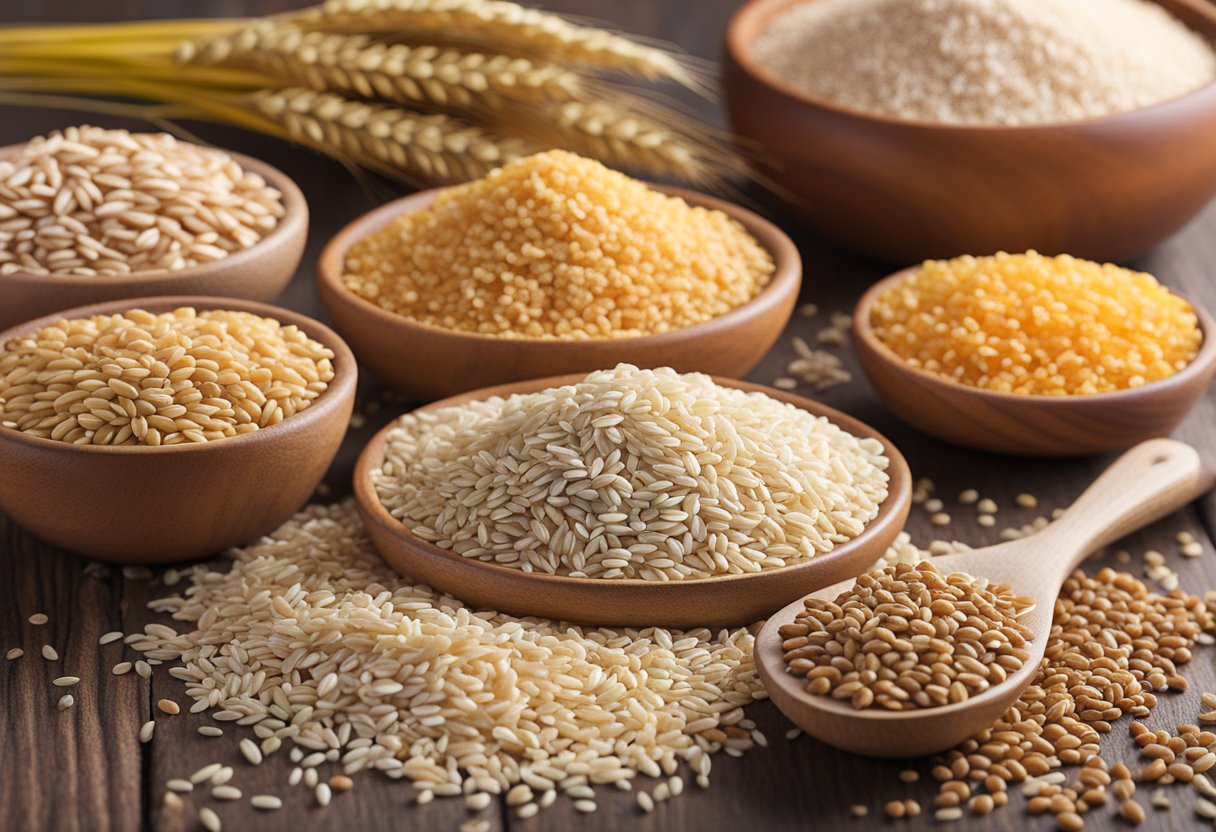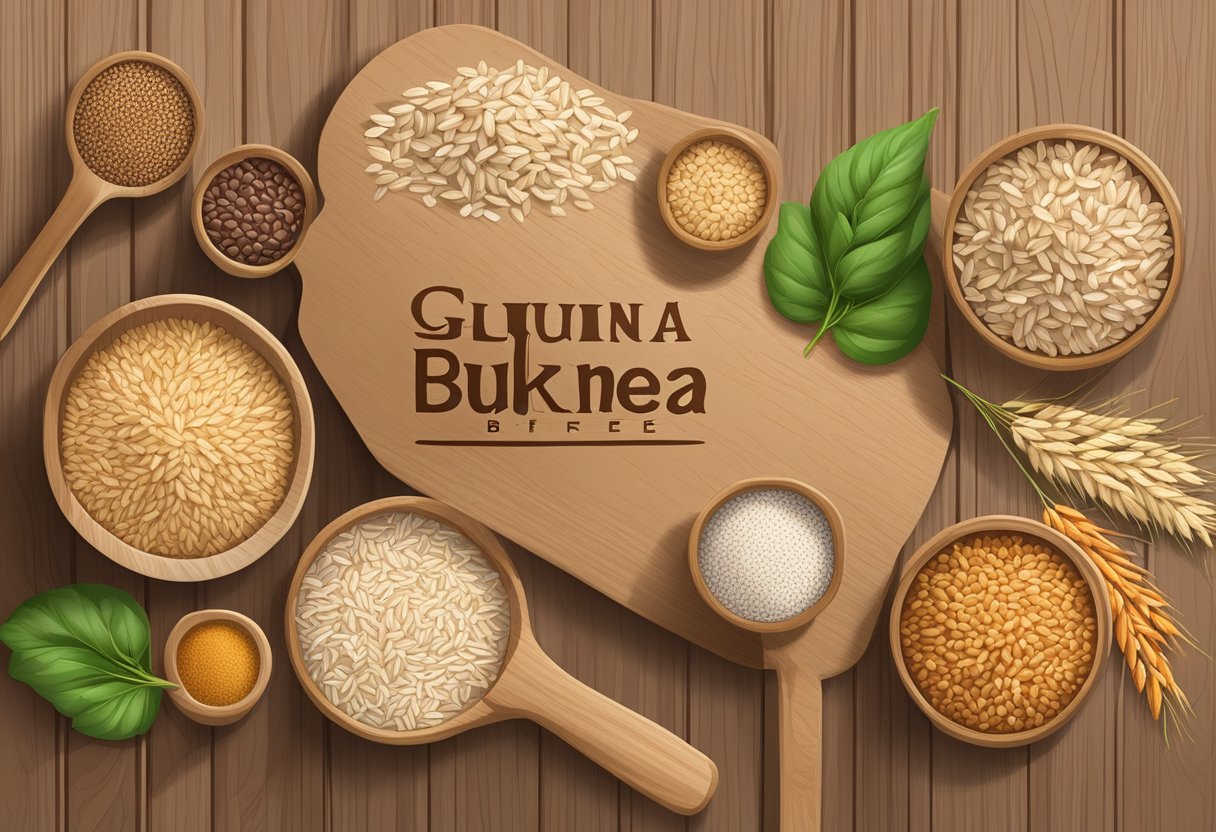Adopting a gluten-free diet involves careful consideration of dietary choices to manage symptoms associated with gluten sensitivity or celiac disease. Whole grains play a crucial role in such diets, providing essential nutrients and health benefits. While certain grains like wheat, barley, and rye contain gluten and are excluded, a variety of naturally gluten-free whole grains offer alternatives that are both nutritious and versatile.

Inclusion of whole grains in a gluten-free diet ensures that individuals do not miss out on fibers, vitamins, and minerals that are inherent to grains like wheat. Amaranth, brown rice, buckwheat, millet, and quinoa are some of the nutritious whole grains that do not contain gluten. These grains not only contribute to the diversity of a gluten-free diet but also help in maintaining a balanced and Mediterranean-inspired menu that is both satisfying and healthy.
Key Takeaways
- Adherence to a gluten-free diet requires replacing gluten-containing grains with gluten-free whole grains.
- Naturally gluten-free whole grains offer dietary fiber, vitamins, and minerals essential for health.
- A Mediterranean-style gluten-free diet can be diverse and nutritious with the inclusion of various gluten-free whole grains.
Table of Contents
Understanding Gluten and Its Effects

Exploring the role of gluten in diet and health is crucial, particularly for those managing celiac disease and non-celiac gluten sensitivity. Identifying the benefits of adopting a gluten-free diet helps in making informed dietary choices.
What Is Gluten?
Gluten is a protein found in grains such as wheat, barley, and rye. It gives elasticity to dough, helping it to rise and maintain its shape. However, for some individuals, gluten consumption can lead to adverse health effects. In the context of a gluten-free Mediterranean diet, alternatives to these grains become essential.
Celiac Disease and Non-Celiac Gluten Sensitivity
Individuals with celiac disease, a genetic autoimmune disorder, experience damage to their small intestine when consuming gluten. Symptoms can include diarrhea, bloating, rash, and constipation. Non-celiac gluten sensitivity also triggers symptoms without the autoimmune response, yet still necessitates a gluten-free diet for relief.
Benefits of a Gluten-Free Diet
Adopting a gluten-free diet is essential for individuals with gluten-related disorders to manage symptoms and prevent complications such as nutritional deficiencies and increased risk of other diseases, including type 2 diabetes. A proper gluten-free diet should be rich in nutrients and fiber to contribute positively to overall health and energy levels.
Whole Grains and Nutritional Benefits
Incorporating whole grains into a gluten-free Mediterranean diet enhances nutritional intake by providing essential vitamins, minerals, and fiber. These nutrients are pivotal for maintaining overall health and can significantly contribute to the diet’s effectiveness.
Defining Whole Grains
Whole grains consist of all three key parts of the grain kernel: the bran, germ, and endosperm. Unlike refined grains, which have been processed to remove the bran and germ, whole grains retain their nutritional profile. This includes a high content of fiber, B vitamins, protein, iron, and magnesium—all crucial for a well-rounded gluten-free diet.
Nutritional Content of Whole Grains
The nutritional content of whole grains is vast and essential for a healthy diet. Here’s a concise breakdown:
- Fiber: Aids in digestion and can help stabilize blood sugar levels.
- Protein: Essential for muscle repair and growth.
- B vitamins: Important for a variety of metabolic processes.
- Iron: Necessary for oxygen transportation in the blood.
- Magnesium: Involved in over 300 biochemical reactions in the body.
Whole grains that fit into a gluten-free Mediterranean diet include amaranth, brown rice, buckwheat, millet, quinoa, sorghum, and teff. Each of these grains brings a wealth of nutrients and health benefits, ranging from weight management to reduced risk of chronic diseases. For those avoiding gluten, these grains provide fantastic nutritional alternatives without compromising on health or flavor.
Key Gluten-Free Whole Grains

In a gluten-free Mediterranean diet, whole grains play a crucial role as they offer essential nutrients, fiber, and texture to various dishes.
Popular Gluten-Free Grains
Rice: A versatile staple, rice comes in varieties such as brown, black, and wild rice. Brown rice retains its nutrient-rich bran and germ during processing, making it a nutritious choice. Wild rice, which is actually a grass, also fits well within a gluten-free Mediterranean diet.
Quinoa: Aside from being a complete protein, quinoa offers high levels of fiber and B-vitamins, making it a popular pseudo-grain. It’s a great substitute for bulgur or couscous and can be used in salads and as a side dish.
Corn: Corn can be found as whole kernels, cornmeal, or polenta. Its versatility allows it to appear in a variety of Mediterranean dishes, from polenta to gluten-free breads and pastries.
Buckwheat: Despite its name, buckwheat is a gluten-free pseudo-grain. Its grains, known as groats, can be cooked similarly to oatmeal or ground into flour for use in noodles like soba.
Oats: Although naturally gluten-free, cross-contamination with gluten can occur. However, pure, uncontaminated oats are an excellent gluten-free option rich in fiber.
Niche Gluten-Free Grains
Millet: Millet is a small, versatile grain that can be added to bread for a crunchy texture or served soft, much like mashed potatoes. It’s a great source of magnesium and phosphorus.
Amaranth: Amaranth is a lesser-known ancient grain with a high protein content and a peppery taste, which can be puffed or popped for adding a delightful crunch to salads or cereal.
Sorghum: Known for its mild flavor, sorghum is often used in gluten-free flour blends. It can also be popped like popcorn or cooked as a porridge.
Teff: Tiny in size, teff is densely packed with nutrients including calcium and resistant starch, a beneficial form of dietary fiber. It’s commonly used to make injera, a traditional Ethiopian flatbread.
Incorporating Whole Grains into a Gluten-Free Diet
Exploring whole grains within a gluten-free diet not only diversifies the plate but also enhances nutritional intake. These grains serve as hearty substitutes for gluten-containing counterparts, offering a variety of flavors and textures that can enliven meals from breakfast to dinner.
Cooking with Gluten-Free Grains
For those managing a gluten-free diet, cooking with gluten-free grains like quinoa, buckwheat, or millet can significantly enrich the diet with essential nutrients. These grains are versatile and can be incorporated into a myriad of recipes. Cooking quinoa or millet provides a nutritious base for Mediterranean breakfast bowls or savory side dishes, playing a fundamental role in maintaining a balanced diet. It is crucial to avoid cross-contamination by using separate cookware and utensils when preparing these gluten-free options to ensure they remain safe for those with celiac disease or gluten sensitivity.
Gluten-Free Grains for Baking
Baking with gluten-free grains requires selecting the right flours that will give structure and flavor to the final product. Rice flour, tapioca, and potato flour are widely used in creating gluten-free dough for cookies and cakes. These flours blend well with Mediterranean diet elements, offering an approach to gluten-free baking that does not compromise on taste or texture. To achieve the best results, individuals should experiment with different grain flours in their recipes, adjusting ratios to perfect the consistency and flavor of their baked goods.
Reading Food Labels for Gluten-Free Whole Grains
When shopping for gluten-free whole grains at grocery stores, careful label reading is essential to ensure products do not contain gluten or have not been subject to cross-contamination during processing. Consumers should look for labels that specifically state the product is gluten-free. Certifications from recognized gluten-free organizations add another layer of trust and safety. Understanding the fundamentals of a gluten-free diet and knowing the names of gluten-free grains can assist in making informed choices when perusing the aisles for safe and healthy options.
Health Considerations for a Gluten-Free Diet
Embarking on a gluten-free diet necessitates a thoughtful approach to nutrition to ensure overall health. Individuals must consider the benefits and adjustments required to maintain a heart-healthy and nutrient-rich diet while restricting gluten.
Whole Grains and Heart Health
Whole grains are a pivotal component of a heart-healthy diet. Despite the elimination of gluten, the inclusion of gluten-free whole grains like quinoa, brown rice, and oats can contribute significantly to cardiovascular well-being. These grains are high in fiber which is known to reduce the risk of heart disease. They can also provide essential nutrients like B vitamins, iron, and magnesium.
Managing Weight and Blood Sugar
A well-structured gluten-free diet can assist with weight management and blood sugar regulation. Complex carbohydrates from gluten-free grains, along with high-fiber vegetables and legumes, can help in maintaining a healthy body weight. They are also crucial in managing type 2 diabetes as they prevent spikes in blood sugar by slowing down glucose absorption.
Gluten-Free Diet and Overall Nutrition
A gluten-free diet can still be rich in nutritional content if it includes a variety of fruits, vegetables, beans, and legumes. These foods not only add vitamins and minerals but also diversify the diet to provide antioxidants and phytochemicals. A Mediterranean-inspired gluten-free diet focuses on these nutrient-dense foods while minimizing saturated fat and added sugars, fostering a well-rounded, healthy diet.
Avoiding Gluten Contamination

Maintaining a strict gluten-free diet requires diligent avoidance of cross-contamination, particularly for individuals with celiac disease or wheat allergy. Understanding where and how gluten contamination can occur is key for anyone processing gluten-free foods, whether at home or industrially.
Understanding Cross-Contamination
Cross-contamination occurs when gluten-free foods come into contact with gluten-containing particles, posing a significant risk for those with gluten sensitivities. This can transpire through shared kitchen equipment, such as cutting boards and toasters, or through improper handling. To prevent cross-contamination, one should use separate, dedicated kitchen tools and consistently clean surfaces when preparing gluten-free meals.
Gluten-Free Food Processing
The processing of gluten-free foods must adhere to stringent procedures to eliminate any exposure to gluten. Manufacturers should implement a controlled workflow, from sourcing raw materials to the packaging of the final product. Facilities often employ separate production lines or designate certain times exclusively for gluten-free production to guard against contamination. Regular testing of products throughout the manufacturing process is crucial to ensure they meet gluten-free standards.
Gluten-Free Alternatives and Substitutes
When embarking on a gluten-free diet, particularly one that aligns with Mediterranean dietary patterns, it’s essential to identify adequate substitutes for gluten-containing grains. These alternatives not only need to provide the texture and flavors that one might miss but should also offer nutritional benefits.
Nuts and Seeds as Gluten-Free Options
Nuts and seeds are invaluable in a gluten-free Mediterranean diet for their versatility and nutrient profile. They can be ground into flours that are perfect for baking, offering a protein-rich alternative to traditional wheat flour.
- Almond flour: Derives from blanched and ground almonds, works well for cakes and cookies.
- Hazelnut meal: Ideal for imparting a rich, nutty flavor in baked goods.
- Flaxseed meal: Adds fiber and a slight nuttiness, plus it acts as a binder in recipes.
Incorporating seeds such as chia and flax can not only enhance the texture of gluten-free dishes but also contribute Omega-3 fatty acids, crucial in a Mediterranean diet. Amaranth and quinoa, while often considered grains, are actually seeds and bring a complete protein source to the table, aligning well with the Mediterranean emphasis on plant-based nutrition.
Gluten-Free Starches and Binders
Tapioca and cornmeal are foundational when it comes to gluten-free starches and binders, commonly used in Mediterranean cooking to create textures and consistency similar to those in gluten-containing dishes.
- Tapioca starch: Extracted from the cassava root, offering elasticity in gluten-free doughs.
- Cornmeal and hominy: Ground from corn, used to make polenta or as a breading, providing a source of whole grain nutrients.
The use of gluten-free starches not only ensures cohesion in dishes but also plays a significant role in fortifying the food with essential vitamins and minerals. These starches and binders are a staple in the Mediterranean kitchen for those following a gluten-free diet, adapting traditional recipes without losing their essence.
Personalizing the Gluten-Free Diet

Embarking on a gluten-free diet can be a daunting task, yet by tailoring it to individual preferences and health requirements, it’s possible to maintain a varied and enjoyable diet. Consulting with a dietitian can ensure that nutritional needs are met, and meticulous meal planning can make this lifestyle both accessible and satisfying, especially when following a gluten-free Mediterranean approach.
Working with a Dietitian
Consulting a registered dietitian is crucial in personalizing a gluten-free diet to maintain optimal health and nutritional content. A dietitian can provide detailed guidance on how to include a variety of naturally gluten-free whole grains such as quinoa, buckwheat, and amaranth that fit within a Mediterranean diet profile. They also offer advice on reading labels, identifying hidden sources of gluten, and ensuring that the diet is rich in nutrients often found in Mediterranean cuisine, like fiber, healthy fats, and antioxidants.
Gluten-Free Meal Planning
Effective meal planning is key to a successful gluten-free Mediterranean diet. It involves strategizing weekly menus that include a range of fruits, vegetables, lean proteins like fish and poultry, and healthy fats such as olive oil, all staples of the Mediterranean diet that are naturally free from gluten. Individuals can utilize specialized gluten-free cookbooks geared toward Mediterranean recipes to diversify their meals. Writing down a detailed grocery list ensures that all ingredients are on hand for healthy cooking throughout the week, and prepping meals in advance can save time and reduce the risk of cross-contamination with gluten-containing products.
Frequently Asked Questions
In this section, we address common inquiries regarding gluten-free alternatives, grains to avoid due to gluten, safe whole grains for a gluten-free diet, handling oats to prevent contamination, ancient grains, and incorporating whole grains into a gluten-free diet with a Mediterranean focus.
What are some gluten-free alternatives to wheat flour?
Gluten-free alternatives to wheat flour include almond flour, coconut flour, and chickpea flour. These flours are used frequently in Mediterranean recipes to create gluten-free breads and other baked goods.
Which grains should be avoided due to their high gluten content?
Individuals following a gluten-free diet should avoid wheat, barley, rye, and triticale. These grains contain gluten, a protein detrimental to those with celiac disease or gluten intolerances.
Can you list some whole grains that are safe for a gluten-free diet?
Safe whole grains for a gluten-free diet encompass amaranth, millet, and teff. These grains are commonly utilized in Mediterranean cuisine and are packed with nutrients.
How can oats be included in a gluten-free diet without contamination?
Oats can be included in a gluten-free diet by selecting brands that are certified gluten-free, ensuring they have not been contaminated by wheat during processing. Oats can be a nutritious part of a gluten-free Mediterranean diet when handled properly.
What constitutes ‘ancient grains’ and are they gluten-free?
‘Ancient grains’ refer to grains that have remained largely unchanged over thousands of years. Examples include quinoa and sorghum, both of which are gluten-free and well-suited to a Mediterranean diet.
How can whole grains be incorporated into a gluten-free diet efficiently?
Whole grains can be incorporated into a gluten-free diet by substituting them in recipes that traditionally use gluten-containing grains, such as using quinoa in tabbouleh instead of bulgur. Additionally, these grains can be added to soups, salads, and stews to enhance their nutritional value within a Mediterranean dietary framework.



